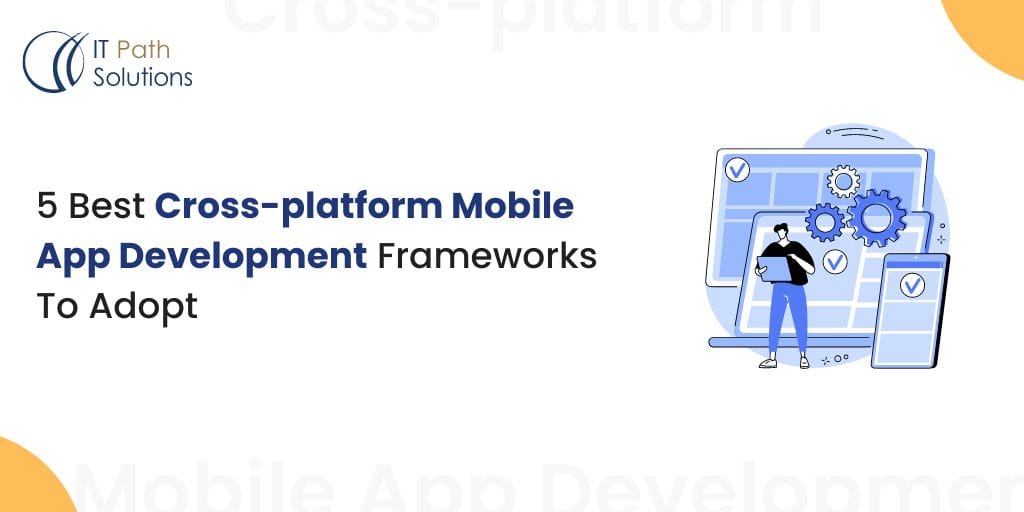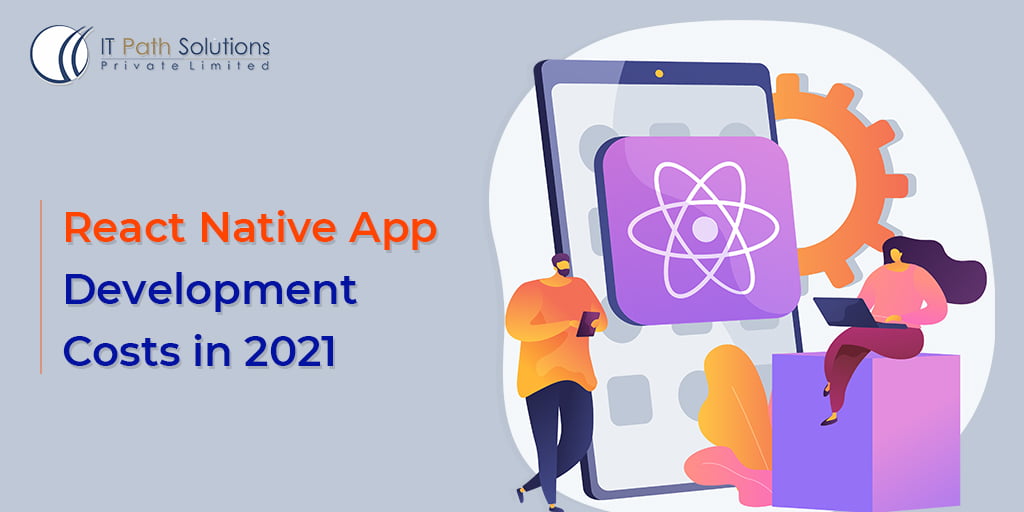5 Best Cross-platform Mobile App Development Frameworks To Adopt
Cross Platform Mobile App Development, Mobile app development
Smartphone applications’ performance relies heavily on the app development tools used for their development. With multiple apps operating in various industrial verticals, it has become essential to develop robust, cost-effective, and high-performance applications. Consequently, cross-platform application development has emerged.
Cross-platform apps are backed by cross-platform app development frameworks that ensure the application’s seamless performance across all platforms. In this blog, we will explore various cross-platform app development frameworks that help you launch your application faster and smoother in the market.
A brief about cross-platform app development:
Cross-platform application development is the process of running applications on multiple platforms such as iOS, Windows, and Android using a single code. The code compatibility saves a lot of development time, reduces the cost of app development, and allows you to reach a broader range of audience.
This is one of the major differences between cross-platform app development and native application development.
Now let us discuss the top 5 cross-platform mobile app development frameworks for application development:
What are cross-platform mobile app development frameworks?
Cross-platform mobile application development frameworks are the set of tools that you use to build a robust application. This application can perform seamlessly across Android and iOS.
Our best 5 picks for cross-platform application development are:
- Flutter
- React Native
- Ionic
- Kotlin Multiplatform
- Node.JS
Things to consider while selecting the cross-platform application development tools:
- Consider the speed of application development;
- Explore the feature support each of these frameworks will have;
- Analyze the risk involved with framework selection;
- Consider the cost of application development.
Benefits of Selecting the Right Cross-Platform Application Development Tools:
Mobile app development for any device:
As mentioned above, you can deploy the code across multiple platforms enabling your app to run seamlessly across various devices.
Wider market reach:
By deploying the application on multiple operating systems, you get a chance to reach new audiences quickly.
Cost-effective solution:
Imagine developing two applications at the cost of one. Cross-platform application development seems to be easy on pockets as you are paying developers the price of developing a single code.
Keeping in mind, all these points, cross-platform app development seems to be imperative.
Let us look at the list of cross-platform app development frameworks:
Flutter:
Flutter is an open-source framework that is used as a UI toolkit for making a fast, beautiful, native compiled app for mobile, web, and desktop with one programming language and a single code base. It was initially developed by Google and launched in 2015 at the Dart Developer Summit. Flutter can create apps for the web, Android, Linux, iOS, and Windows from one single code base.
Flutter, uses Dart, a language developed by Google which is based on Java. Hence, developers familiar with Java find it a bit easier to work on Flutter.
Here are the most popular apps made with Flutter
- Google Ads (Utility)
- Alibaba
- Reflectly
Pros of Flutter
Relatively Faster Development: You don’t need multiple teams for each platform.
Complete Control: Due to Flutter’s layered architecture, the developer has control of even the smallest item in the app.
Real-Time Debugging: With Flutter’s hot reload one can see the code in action and make changes if needed to solve bugs and errors.
Cons Of Flutter
New Framework: As it was launched recently, Flutter still has some issues and a relatively smaller user base. But with Google’s support behind this technology, this is a transient problem.
Dart: Dart is a relatively newer language and still has some issues as compared to Swift or Kotlin.
Not 100% Native Look: Flutter relies on Material UI from Google and Cupertino library so it doesn’t always render the UI perfectly.
React Native:
React Native which was released in March 2015, React Native is an open-source cross-platform for developing mobile applications which are developed by Facebook. According to Statista, 42% of mobile app developers are now using React Native to develop mobile apps. It is used for developing both mobile apps as well as web applications. It allows the developers to use React Native along with other native platform capabilities. React Native App Development gives empowerment to the developer by allowing them to use the capability provided by React Native to develop platform-independent apps. It covers many native technologies such as Android, iOS, UWP, and Web.
React Native is written with combined scripting languages like JavaScript or JSX, XML, and React Native is built by using JavaScript and ReactJS which provides some familiarity for developers.
React Native allows developers to offer the same UI and UX to all users whether they be on Android or iOS by using a single code.
Here are some of the most popular apps/tools made with React Native:
- Facebook Ads Manager
- Skype
- UberEats
- Myntra
- Discovery VR
According to Stack Overflow, a survey of developers this year, 40.58% of developers selected React Native due to its native libraries and tools.
Pros of React Native
Time and Cost-efficiency: Most developers are well versed in React Native app development and the large support community can be tapped for any development bottlenecks.
Native Look and Feel of Your Apps: Because it allows you to use many languages such as Swift, Java, etc. the look of the developed app will be quite familiar.
Freedom of Choice for Developers: Developers can create components that appear to be native to each platform and they can use languages they are already familiar with to build apps.
Native Rendering: React Native uses JavaScript to turn the code into native code and then run the app. While this does slow down the app a bit, in most cases it will reduce bugs and improve user experience.
Amazing Community Support: react Native has a large developer base that constantly updates each other on the latest features and bugs and helps each other out with bugs and code issues. This makes the developer’s job easier as he/she can readily use this resource to troubleshoot if needed.
Cons of React Native
Lack of Ready-made Components: In some minor instances, React Native has relatively low choices of custom components that can be deployed, forcing the developer to develop them from scratch.
Requires a JavaScript Bridge: React native turns the React code into native code using JavaScript and then runs the app for the platform. While this is not a massive disadvantage, for very large apps this can pose a problem.
Native coding Still Needed: For some advanced features, native app development experience is still needed. For the end customer, that means he will need to hire some Android app developers and iOS app developers if needed.
Ionic:
Again, Ionic is an open-source UI toolkit used for developing cross-platform applications. It has an easy learning curve and seamlessly integrates with Angular and Vue.Js. Ionic framework allows developers to use HTML5, JavaScript, CSS, and Cordova wrapper programming language to develop an application that has a native-like feel.
Ionic uses Cordova plugins that facilitate easy access to built-in features like Camera, GPS, and Audio Recorder. Ionic framework is easy to learn, making it an easy favorite among developers.
Popular apps built using Ionic:
- JustWatch
- Sanvello
Pros of using the Ionic framework:
Community support:
Ionic is backed by a strong community that helps in solving any doubt instantly. This is the biggest plus why developers are shifting to Ionic.
Ease of learning:
The easy learning curve makes the Ionic framework one of the favorites amongst developers.
Cons of using Ionic framework:
Not suitable for complex applications:
Applications with complexities might face some performance issues when built using the Ionic framework.
Kotlin Multiplatform:
Another favorite of developers for cross-platform application development is Kotlin Multiplatform. Kotlin framework facilitates business logic and code sharing across various platforms. Also, Kotlin Multiplatform allows you to use native UI technologies for application development. This is one of the major benefits why apps built using Kotlin give a native-like feel.
Popular apps built using Kotlin Multiplatform:
- Netflix;
- Cash App;
- VMware;
Pros of using Kotlin Multiplatform:
Seamless integration with iOS and Android:
Codes written in Kotlin seamlessly integrate with the existing iOS and Android codebases.
Gradle Support:
Kotlin extends its support to Gradle, which simplifies dependency management, thereby improving productivity.
Cons of using Kotlin Multiplatform:
Low adoption:
The framework has limited adoption due to its difficult learning curve;
Limited resources:
One will find limited and less comprehensive resources, for a new developer to learn and implement Kotlin development.
Comparatively slow compilation speed:
One might face issues with application compilation when compared to Java. The process might annoy you during the application deployment.
Node.js:
Node.js is an open-source Javascript runtime environment cross-platform app development framework 2024 that runs on Windows, Linux, and MacOS. The open-source environment allows the development of serverside apps that are robust and scalable.
Node.js is known for its efficiency and responsiveness in developing cross-platform applications.
Popular apps built using Node.js:
- Uber;
- LinkedIn;
- eBay
Pros of using Node.js:
Ease of learning:
Node.js is built using Javascript programming language, which is easy to learn and implement.
Fast and Scalable applications:
Applications built using Node.js are extremely scalable. This feature makes Node.js one of the popular choices amongst developers. It functions on a single-threaded model and event loop functionality. This mechanism allows the server to reply without any blockage, hence the scalability of the apps.
Cons of using Node.js:
Asynchronous programming model:
Asynchronous programming refers to the programming method where execution proceeds without waiting for all program elements to be processed. This causes problems for programming elements that can not run independently.
An Overview of Cross-platform application development frameworks:
| Frameworks | Developed By | Date of Release | Repository | Programming Language | Popular Apps |
|---|---|---|---|---|---|
| React Native | 2015 | React Native GitHub | JavaScript, Java, C++, Objective-C, Python |
Facebook Ads Manager Skype UberEats Myntra Discovery VR |
|
| Flutter | 2017 | Flutter GitHub | Dart |
Google Ads (Utility) Alibaba Reflectly |
|
| Ionic | Drifty | 2013 | Ionic GitHub | JavaScript | Sanvello, JustWatch |
| Kotlin | JetBrains | 2011 | Kotlin GitHub | Kotlin |
Netflix; Cash App; VMware; |
| Node.js | OpenJS Foundation | 2009 | Node.js GitHub | C, C++, JavaScript |
Uber; LinkedIn; eBay |
Do you need a cross-platform application?
Well, it looks like cross-platform application development is going to rule the market. It is difficult to decide a clear winner between the cross-platform frameworks, as the selection is very personal and based upon your project requirements.
If you have any new innovative ideas and looking for an app development partner who can help you with it, feel free to consult us. Also, we provide a hire developers facility, where you can hire our vetted developers on an hourly basis. Thank you for reading the blog.
 Healthcare
Healthcare  Education
Education  Real Estate
Real Estate  Logistic
Logistic  Fitness
Fitness  Tourism
Tourism  Travel
Travel  Banking
Banking  Media
Media  E-commerce
E-commerce  Themes
Themes
 Plugins
Plugins
 Patterns
Patterns

